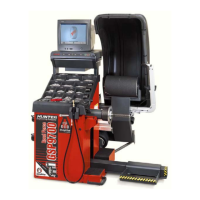GSP9700 Series Road Force Measurement System Operation 4. Balancing a Wheel 39
Selecting Weight Types and Placement Modes
Press “ ” to change the weight types and placement. The GSP9700 offers
Standard Balance, Mixed Weights Balance, Adhesive Weights Balance, and Patch
Balance
for dynamic and static modes.
With these four selections, a correction weight can be placed at an infinite number of
locations, based upon the choice of the operator.
DYNAMIC
STATIC
STANDARD
BALANCE
MIXED
WEIGHTS
BALANCE
DHESIVE
WEIGHTS
BALANCE
PATCH
BALANCE
STANDARD BALANCE should be selected when clip-on weights can be used for
both rim flanges.
MIXED WEIGHTS BALANCE should be selected when a clip-on weight can be used
on the inner rim flange, but not on the outer rim flange. Mixed Weights Balance uses
an adhesive weight for the right weight plane instead of a clip-on weight to avoid
marring aluminum rims or to hide weights from view.
ADHESIVE WEIGHTS BALANCE should be selected when clip-on weights cannot be
used on either rim flange.
PATCH BALANCE should be selected when the tire has a very large imbalance in
the tire assembly. The large imbalance can be corrected with Patch Balancing and
then the assembly can be fine-tuned with one of the other balancing procedures.
STANDARD Balancing Procedure (Using Clip-On Weights)
Verify that the wheel is clean and free of debris.
Remove all previous weights.
Mount tire/wheel assembly. Refer to “Mounting the Wheel,” page 23.
Press “
.”
Use the softkey arrows to select “STANDARD BALANCE” and press “OK.”

